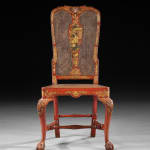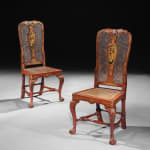Seating
A SET OF SIX GEORGE II SCARLET-JAPANNED SIDE CHAIRS
H: 111.8 cm
W: 48.9 cm
D: 50.8 cm
Further images
Provenance
Private Collection: Bern, Switzerland
Private Collection: California, USA
Literature
H. Huth, Lacquer of the West: The History of a Craft and an Industry, 1550-1950 (Chicago, 1971), fig. 88
Partridge Fine Arts, 1988 Summer Exhibition Catalogue, No. 10, pp. 30-2
A. Bowett, Early Georgian Furniture 1715-1740 (Woodbridge, 2009) p. 158, pl. 4:29
It is especially rare to encounter a set of six red-japanned chairs, remarkably well preserved. Sets of this size seldom survive intact, and their survival today offers a rare glimpse into the luxurious furnishing schemes of grand 18th-century interiors. Decorated with finely detailed figural genre scenes and lively floral motifs in rich gold on a brilliant scarlet ground, these chairs exemplify the height of English japanning—a decorative technique devised to emulate East Asian lacquerwork.
Each chair features a vase-shaped splat and trapezoidal caned seat above cabriole front legs terminating in ball-and-claw feet, joined by a turned H-form stretcher to splayed rear legs. The visual richness of the japanned decoration is matched by the sculptural elegance of their form, which reflects the prevailing Rococo taste for curvilinear lines and expressive movement.
While these chairs are naturally associated with the renowned Infantado suite—a celebrated group of red-japanned furniture supplied by Giles Grendey to the Duke of Infantado for the palace at Lazcano in northern Spain—they differ in structural form and likely represent production from a related London workshop catering to similarly aristocratic or diplomatic clientele. The Infantado commission has come to symbolise the apex of japanned furniture design in England, and the present set shares its vivid palette, decorative confidence, and elite provenance.
Comparable examples include a pair of japanned chairs, though in green and gilt, now in the collection of Colonial Williamsburg, which share closely related splat and leg forms.¹ Another set of six chairs—distinguished by more elaborate crestings and slightly earlier proportions—is illustrated by Partridge, while a stylistically related black-japanned example is recorded by Dr. Adam Bowett.² ³ These parallels situate the present chairs within a small and distinguished group of surviving japanned seat furniture from mid-18th-century England.
Produced during a period of intense European fascination with East Asian lacquerwork and chinoiserie, these chairs are both decorative and culturally significant. Japanning, with its luminous finishes and intricate gilding, offered an exotic and luxurious alternative to traditional furniture decoration. The choice of a brilliant red ground, in particular, was prized not only for its visual drama but also for its symbolic connotations of wealth and sophistication, echoing Chinese cinnabar lacquer.
Functionally and stylistically, chairs of this type were intended for use in formal reception rooms and grand dining settings, where they would serve to communicate the cultural refinement and cosmopolitan taste of their owner. The narrative content of the figural scenes—likely derived from both Chinese and European sources—adds a layer of allegorical or courtly storytelling to the floral decoration, blending the decorative and the didactic in a way that was highly valued during the Rococo era.
As such, these chairs are more than exquisite examples of japanned furniture; they are tangible artefacts of 18th-century aristocratic aspiration, illustrating the intersection of craftsmanship, commerce, and cultural exchange. Their survival as a coherent group only heightens their importance, offering rare insight into the visual language and social meanings embedded in the interiors of Enlightenment Britain.











